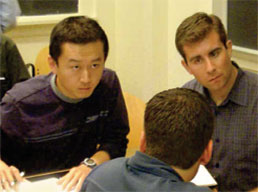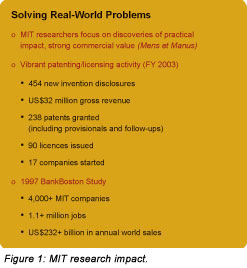|
by Lay Leng TAN

 hat do an engineer and an entrepreneur have in common? More than most people realise, says Thomas L Magnanti, Dean of Engineering at the Massachusetts Institute of Technology (MIT). hat do an engineer and an entrepreneur have in common? More than most people realise, says Thomas L Magnanti, Dean of Engineering at the Massachusetts Institute of Technology (MIT).
The word "engineer" derives from the Latin word ingenium - innate character, talent, or ability. “Entrepreneur” has its roots in the French word entreprendre which means to undertake or take action. An engineer applies mathematics, science, and systems-integrative approaches to conceive, design, build, and operate useful objects or processes; whereas an entrepreneur assumes the tasks of organisation and management as well as the risks of new-project creation or new-venture startup.
In examining engineering and entrepreneurship, Magnanti goes beyond the words to see the two as having a natural symbiosis. As an Institute Professor at MIT, he is the right person to bridge the two: he holds faculty positions in both the Sloan School of Management and the School of Engineering. As Dean of Engineering, he seeks to create a new breed of graduates who, having a strong foundation of technical expertise, also possess the additional leadership qualities of inventiveness, risk-taking, and a sense of adventure.
Among those in whom Magnanti often finds these traits are the Singaporeans, Chinese, and Indians. This observation stands in contrast to a persistent perception held by many that Asians are staid or even stoic. Although Asians cannot be lumped together into a homogeneous whole since they exhibit a wide range of national or ethnic variations, still, Eastern culture inclines towards conservatism by and large, particularly in risk- and mistake-avoidance. But today, the traditional culture is changing.
In the entrepreneurship clusters on the East and West Coasts of the US, one will also find certain “cultural” differences. The West Coast has Stanford, Silicon Valley, and San Diego; prominent on the East Coast are MIT and biotechnology centres in Cambridge. Magnanti comments: “There is a perception that the East Coast is more conservative; therein lies an element of truth. So, in the surrounding culture, maybe MIT is a bit of an anomaly because we spin out patents and activities all the time.”
For fiscal year 2003, MIT's Technology Licensing Office reported over 450 invention disclosures and about 20% (17) of its licenses granted to startup companies. “While our Route 128 [a ring road around Boston along which many technology companies are clustered] community might not have developed as quickly as Silicon Valley in recent years, as many as 75% of the Route 128 companies have been founded or are led by MIT alumni."
 In the first national study of the economic impact of a research university conducted several years ago (Figure 1), BankBoston found that graduates of MIT have founded 4,000 firms, translating their knowledge into products, services, and jobs. These firms in 1994 employed over one million people and generated worldwide revenues of US$232 billion. About US$1 billion in sponsored research is conducted at MIT annually, with nearly half of that at MIT's campus in Cambridge, Massachusetts. In the first national study of the economic impact of a research university conducted several years ago (Figure 1), BankBoston found that graduates of MIT have founded 4,000 firms, translating their knowledge into products, services, and jobs. These firms in 1994 employed over one million people and generated worldwide revenues of US$232 billion. About US$1 billion in sponsored research is conducted at MIT annually, with nearly half of that at MIT's campus in Cambridge, Massachusetts.
When asked whether entrepreneurship can be inculcated, Magnanti replies that MIT is working to fuel more innovation and entrepreneurship; he affirms that elements of entrepreneurship can indeed be taught. "A lot comes from what I call 'touching the leaves' of Cambridge, Massachusetts. Something of the spirit of entrepreneurship is in the air, a culture of innovation we all absorb, whether we are inherently entrepreneurial or not."
He also believes students can learn certain things entrepreneurship entails, like how to finance companies and market them. Of course, being innately enterprising helps a great deal, but everyone can learn about it. An example of education in emerging technologies that links the classroom to the laboratory is “i-Teams” (short for Innovation Teams). Jointly taught by faculty in the School of Engineering and the MIT Sloan School of Management, this unique new course enables graduate students to engage in the process of bringing MIT innovations from the lab bench to the market. Each semester, students apply to join one of five teams based on technologies funded by the Deshpande Center for Technological Innovation. They then engage in a rigorous and selective process that introduces them to the dynamics of team formation. The resulting i-Teams develop go-to-market strategies for their research projects with the guidance of faculty and volunteers from the business community. Technologies for the fall 2004 semester include medical devices, microfluidics, fuel cells, colloidal crystals, and wireless communication.
The research laboratories also breed entrepreneurship. Students benefit from working with faculty members who are enterprising inventors. Apprenticeship, tutoring, and formal instruction serve as "courses" in management and financing. "We in engineering don't study entrepreneurship per se; we do entrepreneurship. We create products and processes that people use. Bringing together management and engineering provides an ideal combination - teach the underlying scholarship and theory and study real-life scenarios by people who are doing it," Magnanti explains.
The Singapore-MIT Alliance programme is implementing this approach. During their stint at MIT, NUS students undergo several days of entrepreneurship immersion, meeting with experienced entrepreneurs who imbue them with the “entrepreneurial” spirit. However, merely learning the ropes does not suffice, Magnanti stresses. "You need a supporting ecosystem to provide the right incentives, structure, and freedom." He sees Singapore as having the infrastructure, capital, and talent; however, he feels the nation needs an infusion of more risk-taking.
Magnanti has chaired the skills working group of the US Council on Competitiveness' National Innovation Iniatitive that has presented a set of recommendations to the US government concerning innovation. For example, a proposed US National Innovation Education Act, patterned after the National Defense Education Act (NDEA) of the 1950s, would serve as a vehicle for attracting more graduate students interested in innovation to engineering and science.
He recommends that the government not choose which technology to pursue but instead let the market decide. As MIT professor Vannevar Bush, former director of the Office of Scientific Research and Development, proposed in his report The Endless Frontier, government should provide research funding but adopt a hands-off approach while universities provide the talent to fuel industrial development in the US economy.
However, a small country like Singapore might require a different strategy. Magnanti notes: "Perhaps the Singaporean approach is appropriate for the island nation, and the American approach the right one for the US. The need remains to balance a certain amount of governmental support and direction with a certain amount of autonomy. So far, the government’s efforts in creating the spirit of autonomy and entrepreneurship on US campuses are paying off."
Engineering has certain advantages in the translation of technology into application and entrepreneurship, as the number of successful examples shows. Biology is also heading in a direction in which innovation in life sciences can pay rich dividends.
What advice does the dean have for the aspiring researcher-entrepreneur?
"Strike a balance. Obtain a strong grounding in science, maths, and technology because entrepreneurs need to have some understanding of basic underlying technologies. A broad base also provides perspective on the context in which innovation occurs — the entrepreneurship ecosystem. Finally, some knowledge of the market and finances is essential.
"What I would argue against is someone’s becoming exclusively technology-focused or someone else’s studying entrepreneurship without a firm understanding of the technological base. Much of the work comes from the complementary relationship between management and engineering. I have actually spent most of my career at this interface.
 Click here to download the full issue for USD 6.50 Click here to download the full issue for USD 6.50
|



 hat do an engineer and an entrepreneur have in common? More than most people realise, says Thomas L Magnanti, Dean of Engineering at the Massachusetts Institute of Technology (MIT).
hat do an engineer and an entrepreneur have in common? More than most people realise, says Thomas L Magnanti, Dean of Engineering at the Massachusetts Institute of Technology (MIT).
 In the first national study of the economic impact of a research university conducted several years ago (Figure 1), BankBoston found that graduates of MIT have founded 4,000 firms, translating their knowledge into products, services, and jobs. These firms in 1994 employed over one million people and generated worldwide revenues of US$232 billion. About US$1 billion in sponsored research is conducted at MIT annually, with nearly half of that at MIT's campus in Cambridge, Massachusetts.
In the first national study of the economic impact of a research university conducted several years ago (Figure 1), BankBoston found that graduates of MIT have founded 4,000 firms, translating their knowledge into products, services, and jobs. These firms in 1994 employed over one million people and generated worldwide revenues of US$232 billion. About US$1 billion in sponsored research is conducted at MIT annually, with nearly half of that at MIT's campus in Cambridge, Massachusetts.
 Click here to download the full issue for USD 6.50
Click here to download the full issue for USD 6.50